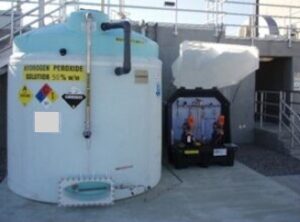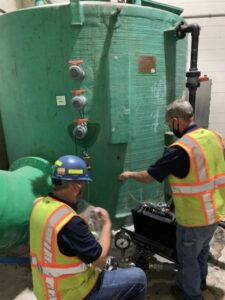Is an H2O2 Water Treatment System Right for Your Facility? A Simple Guide to Deciding
 Many treatment facilities today are rethinking how they handle odor and corrosion. New regulations, aging infrastructure, and community pressure are pushing operators to look for better, cleaner ways to manage these issues. One method gaining attention is the use of hydrogen peroxide (H2O2) water treatment systems.
Many treatment facilities today are rethinking how they handle odor and corrosion. New regulations, aging infrastructure, and community pressure are pushing operators to look for better, cleaner ways to manage these issues. One method gaining attention is the use of hydrogen peroxide (H2O2) water treatment systems.
Hydrogen peroxide is not new, but it’s now being used more often for odor control in wastewater and industrial settings. It reacts quickly with odor-causing compounds and has fewer side effects than many traditional chemicals. At Webster Environmental Associates (WEA), we help facilities decide whether H2O2 is the right fit, and if so, how to design a system that works.
Are You Dealing With Hydrogen Sulfide or Odorous Sulfides?
Hydrogen sulfide (H₂S) is one of the most common and unpleasant odors in wastewater. It also causes corrosion and safety concerns. If your facility is struggling with H₂S in gravity sewers, force mains, or treatment plant headworks, H2O2 may be a strong option.
Hydrogen peroxide reacts directly with hydrogen sulfide in the water. The reaction converts H₂S into elemental sulfur or sulfate, both of which are less harmful and much less odorous. The process happens quickly, even with short retention times, which makes it useful for many common problem areas.
If your main issue involves sulfide buildup, H2O2 is a treatment worth considering.
Do You Need Fast, Targeted Treatment?
Some odor control systems take time to work. Others need large infrastructure changes. Hydrogen peroxide works fast and can be applied with compact equipment.
This makes it ideal for temporary use during construction, repairs, or emergencies. It’s also useful as a supplemental treatment in systems where other methods are already in place but not performing well.
At WEA, we’ve designed H2O2 systems for both long-term and short-term use. We create injection setups that are flexible and easy to scale based on your flow, odor levels, and space. If you’re looking for a quick fix or a stopgap while planning for a larger upgrade, H2O2 may be a good option.
Are You Trying to Avoid Other Chemicals or Their Byproducts?
Every odor control chemical has trade-offs. Nitrate solutions are common, but they can add nutrients to the system. Iron salts are effective but highly corrosive and may require large doses. Magnesium hydroxide can increase solids and sludge volume.
Hydrogen peroxide stands out for its clean chemical reaction. It doesn’t leave behind sludge or heavy metals. It doesn’t add nitrogen or phosphorus to the water. It reacts quickly and breaks down into water and oxygen.
For facilities looking to avoid the complications of other chemicals, H2O2 offers a simpler and cleaner approach. It’s especially useful where discharge quality is a concern or where systems need to minimize chemical buildup.
Can You Safely Handle a Hazardous Chemical Onsite?
 While hydrogen peroxide offers many benefits, it does come with safety requirements. It is a strong oxidizer and needs careful handling. Storage tanks, feed systems, and safety equipment must meet specific standards.
While hydrogen peroxide offers many benefits, it does come with safety requirements. It is a strong oxidizer and needs careful handling. Storage tanks, feed systems, and safety equipment must meet specific standards.
That’s why WEA works closely with clients to plan ahead. We help design secondary containment, train staff, and put monitoring in place. Safety is always a top priority in our system designs.
If your team has the resources to manage a chemical safely—and is committed to following best practices—H2O2 can be used effectively with little risk. But if storage or training is limited, another treatment method may be better.
What WEA Evaluates Before Recommending H2O2
Choosing a treatment method shouldn’t be a guessing game. At WEA, we evaluate each site before making a recommendation. We consider factors like:
- Flow rate and detention time
- Odor and sulfide concentrations
- Type and size of infrastructure
- Space for equipment
- Operator experience
- Goals for long-term performance
We also compare H2O2 to other options like nitrate, iron salts, oxygen injection, and biological treatment. Not every site is right for hydrogen peroxide, and that’s okay. Our role is to find what works best based on real data and experience.
Need Help Deciding? Let’s Talk
Hydrogen peroxide can be a smart, effective way to handle odor and sulfide problems—but only if the system is designed and used correctly. If you’re wondering whether an H2O2 water treatment system makes sense for your facility, we can help.
Webster Environmental Associates has decades of experience evaluating odor sources, testing treatment options, and supporting clients through installation and monitoring. Whether you’re exploring options or ready to plan a system, we’re here to guide the process.
Contact us today to schedule an odor evaluation, flow test, or planning consultation. We’ll help you decide whether hydrogen peroxide is the right fit—and if it is, we’ll make sure the system works for your site.
